E-Archive
Articles
in Vol. 13 - July Issue - Year 2012
Pre-Plating Vibro-Finishing, Environmently Friendly Processes At Competitive Costs
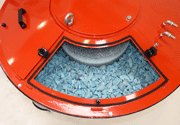
Orbital machine RWO-D-330-MF-AIR equipped with control board and automatic dosing station for Microfluid compounds, Abragel series
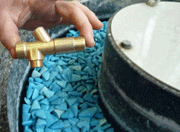
Example of valve body polished with Microfluid process, classic example of pre-plating finishing
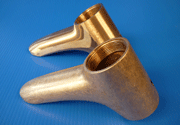
Example of brass mixer group polished with Microfluid process
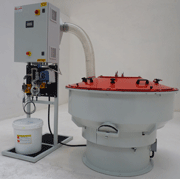
Orbital machine RWO-D-330-MF-AIR for Microfluid processes, equipped with final drying device for the treated parts
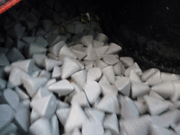
Mass of QF30NPV media, Pirakon shape (half pyramid and half cone), moving inside a vibrating machine, with Microfluid additive of the Abragel series
Metal surfaces mass finishing, also known as tumble finishing and vibro-finishing, is going through a very interesting renovation phase.
There are at least two keys to understanding this phase: strongly reduced environmental impact and decisive process costs reduction.
This phase has at least two main characteristics: an innovative finishing media (i.e.: abrasive chip) called QF and a series of processes called Microfluid, both patented (patent pending – I).
Let’s start with the result, that is, with the above-mentioned statements about the strongly reduced environmental impact and the decisive process costs reduction, to see how we can get there.
The first step was made thanks to the new technology offered by abrasive chips or even the finishing media called QF.
This kind of media, whose complete name is "Quattrofinish", is unconventional and of slightly difficult understanding. It presents right away with some "disadvantage" because it is more expensive than other widely known plastic and ceramic abrasive chips. However, the initial ice regarding this product, more related to technical matters than to commercial matters, can easily turn into lukewarm water.
All it takes is, in fact, putting a bag of this material into a machine normally used with conventional media to realize that the new QF media last extraordinarily up to ten times longer, if not even longer, than any normal "ceramic" and "plastic" media known on the market.
But in practice, what’s the advantage in using these new media?
The answer comes from an innovative series of processes, called Microfluid.
These processes are able to act simultaneously with the QF media delivering the desired result through both the wished abrasiveness level and finishing level. Microfluid processes, in fact, are based on automatic adjunction, through very simple dosing devices designed to add gel abrasives into the bowl of the vibrator. The gel itself is equipped with its own "micro water supply" combined with abrasives, and is able to produce the same effect of much higher quantities of water produced in regular processes (e.g. in those where plastic chips and water are used, or where ceramic chips with water and a liquid chemical additive are used).
During Microfluid processes, a very tiny dosing pump provides the supply of small water drops, conveniently spread in time, ensuring a steady micro-moistness also in the long cycles, needed to make sure that the abrasive gels stays attached to the media surface and, therefore, is always active on the metal surfaces undergoing the vibro-finishing process.
In the very short final phase, a rinsing takes place, which, thanks to the composition of the Microfluid compounds, ensures a thorough but quick rinsing of the metal parts.
When requested, once the water has been taken out of the machine (drop-out phase), there can be an automatic hot air drying phase, compatible with the "non abrasive" features of some kinds of QF media, making it possible for only one machine to carry out the whole finishing, rinsing and drying processes, followed by automatic or manual unloading of the parts at the end of the cycle, based on the machine model.
This development of the Microfluid process generates interesting outcomes for the final user, briefly summarized as follows:
Efficiency of the process
Comparing a classic process to a Microfluid process, the same results can be reached in half the time. In some cases, with similar times, surfaces polished through Microfluid processes have slightly better results; that is to say, they result in smoother and thinner outcomes (e.g. a brass handle, using the same time, results 0,47 µm/RA with plastic chip and 0,38 µm/RA with QF and Microfluid compound).
Basically, time is not the decisive factor to determine the differences between these new processes and the traditional ones.
Water consumption
Water consumption in Microfluid processes compared to conventional processes is reduced 8- to 10-fold, or even more (the longer the process, the lower the water consumption volume). Taking for example a couple of cycles per day in a machine with a 600 lt capacity working 18-20 hours/day, the water consumption can go from about 1200 lt/per day to about 150 lt/ per day.
Filtration "SS"
The suspended solids, that in a traditional process are difficult to hold through a regular filter bag because it would fill with water in a few hours and make the attempt groundless, can be easily filtered in a Microfluid process, because the quantity of added liquid is irrelevant and at the same time it can easily drain during the cycle. When facilitating the filtering of the suspended solids from the very beginning, at the end all we’ll find is water with some polluting liquid substances. The cost for the disposal of these liquids will be much lower than that to be paid for the same amount of solid SS waste and, in conclusion, the volume of material to be treated will be reduced by the SS mass kept away at the beginning.
Mud reduction
The mud amount produced by the media consumption is very limited. At the same time, the cost for the use of the new QF media, regardless of the more expensive initial price, is very often 50%-70% lower than conventional media. A minor mud production means lower disposal costs.
Reduction of the "below measure"
The frequencies on which traditional media wear off normally cause relevant selection problems that can be remarkably decreased with the use of the new QF media.
Transport and stocking costs reduction
Having a consumption rate 10 times lower than normal, we can certainly foresee a pollution reduction, due to the lower number of transportations, and of course also a reduction of the costs. Consequently, stocking costs will also decrease.
Manpower costs reduction
In several articulated processes, e.g. rough deburring through ceramic media, followed by polishing through plastic media, followed by final drying, implies, in case of delicate articles to be unloaded and manually picked up, the intervention of an operator to pick up the treated parts from the machine loaded with ceramic media to put them into the machine loaded with plastic media. Thereafter, it is necessary for the operator to pick up the treated parts from the machine loaded with plastic media and to put them into the dryer. Thanks to Microfluid technology, it is now possible to buy one vibrating machine only instead of three, because the intermediate passages among the phases happen automatically: the first gel (automatically pumped) functions as aggressive abrasive just like any other ceramic media; the second gel (automatically pumped) functions as polishing abrasive just like any other plastic media; and the thorough rinsing followed by automatic dripping and drying will make sure that the treated parts land into the hands of the operator completely dry at the end of each cycle.
Summary
With reference to multi-phase processes or with final drying, we can summarize as follows: reduced/decreased investment, less space and less manpower needed (from 2:1 up to 3 : 1), strongly reduced polluting waste water emission, less mud… nevertheless, it is also possible to adjust EXISTING plans, simply by equipping them with a user-friendly dosing station, a suitable control board, and a filter bag unit…with even greater benefits.
How to evaluate the feasibility of a process
Rollwasch® Italiana S.p.a. test room and its workshops are the fastest way to make a preliminary evaluation, without costs or engagement.
For Information:
Rollwasch® Italiana S.p.a.
Via San Carlo, 21
20847 Albiate (MB), Italy
Tel. +39.0362.930334
Fax +39.0362.931440
E-mail: info@rollwasch.it
www.rollwasch.it



























